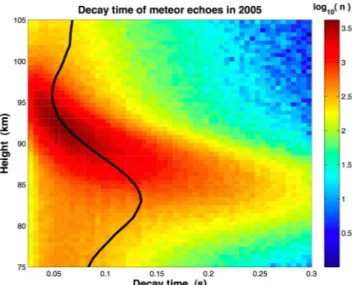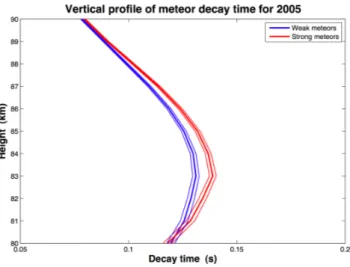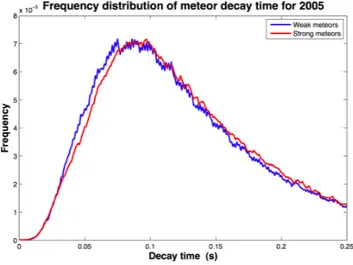www.ann-geophys.net/26/3439/2008/ © European Geosciences Union 2008
Annales
Geophysicae
Communica
tes
On the validity of the ambipolar diffusion assumption in the polar
mesopause region
A. P. Ballinger1, P. B. Chilson2, R. D. Palmer2, and N. J. Mitchell3
1Program in Atmospheric and Oceanic Sciences, Princeton University, Princeton, NJ, USA
2School of Meteorology and Atmospheric Radar Research Center, University of Oklahoma, Norman, OK, USA 3Department of Electronic & Electrical Engineering, University of Bath, Bath, UK
Received: 26 June 2008 – Revised: 30 October 2008 – Accepted: 31 October 2008 – Published: 6 November 2008
Abstract. The decay of underdense meteor trails in the po-lar mesopause region is thought to be predominantly due to ambipolar diffusion, a process governed by the ambient tem-perature and pressure. Hence, observations of meteor decay times have been used to indirectly measure the temperature of the mesopause region. Using meteor observations from a SKiYMET radar in northern Sweden during 2005, this study found that weaker meteor trails have shorter decay times (on average) than relatively stronger trails. This suggests that processes other than ambipolar diffusion can play a signicant role in trail diffusion. One particular mechanism, namely electron-ion recombination, is explored. This process is de-pendent on the initial electron density within the meteor trail, and can lead to a disproportionate reduction in decay time, depending on the strength of the meteor.
Keywords. Atmospheric composition and structure (Pres-sure, density, and temperature; Instruments and techniques)
1 Introduction and background
At any location during any given day, many thousands of meteors enter our Earth’s upper atmosphere. The frequency of incoming meteors fluctuates but generally follows a well-understood diurnal and seasonal cycle. Most of the mete-ors ablate as they interact with the increasingly dense air molecules, leaving an ionized plasma trail in their wake. A meteor radar is able to detect these short-lived trails (herein referred to as “meteor echoes”), enabling certain useful pa-rameters, such as drift velocity, decay times, etc., to be esti-mated.
Consider the idealized case where the radius of a meteor trail is much smaller than the radar wavelength, and the ef-fects of diffusion can be ignored. Further, assume the trail is Correspondence to:A. P. Ballinger
(aballing@princeton.edu)
“underdense”, meaning each electron in a meteor trail scat-ters independently, with a scattering cross-section given by
σe= µ20e4
16π2m2, (1)
whereµ0,mandeare the magnetic permeability of air,
elec-tron mass, and elecelec-tron charge, respectively.
By assuming ambipolar diffusion is the predominant mechanism by which the meteor echo decays, the backscat-tered power will fall off from an initial value ofP0according
to
P (t )=P0exp
"
−32π
2D at
λ2
#
, (2)
whereDa is the “ambipolar diffusion coefficient”, andt is the time after the initial peak power (Chilson et al., 1996). Defining a “decay time”,τ1/2, as the time taken for the power
to drop to half the peak, the ambipolar diffusion coefficient can be estimated from the meteor echo decay time by
Da=
λ2ln 2 16π2τ1
/2
. (3)
This ambipolar diffusion coefficient is dependent on the at-mospheric temperature,T, and pressure,p, through the rela-tion
Da=Kamb T2
p , (4)
where Kamb is a constant (Jones and Jones, 1990; Jones,
Fig. 1. Decay time versus height of all meteors during 2005. Color
shading indicates the number of meteors,n(per 500 m×5 ms
win-dow). The solid line indicates the mean decay time.
method of temperature estimation that uses ablating meteors requires the assumption that ambipolar diffusion alone gov-erns the decay of the underdense meteor echoes. However, alternative mechanisms exist, which can also affect the decay rate (Dyrud et al., 2001; Havnes and Sigernes, 2005; Dimant and Oppenheim, 2006a,b; Holdsworth et al., 2006).
2 Instrumentation and observations
In order to investigate the decay of meteor echoes, observa-tions taken from a Very-High-Frequency (VHF) meteor radar located at Esrange, near Kiruna, in northern Sweden, dur-ing 2005 were analyzed. The All-Sky Interferometric Me-teor Radar (SKiYMET) system is a multi-channel coherent receiver pulsed radar capable of observing a wide range of parameters through the detection and analysis of faint mete-ors (see Hocking et al., 2001, for details).
The radar transmits at 32.5 MHz (λ=9.23 m), with a typ-ical pulse repetition frequency (PRF) of 2143 kHz. A pulse length of 13.3µs corresponds to a relatively poor range res-olution of 2 km, which leads to some uncertainty as to the altitude of any given meteor trail. However, the coarser reso-lution means that a meteor trail is most likely fully contained within a range gate, which is important in building accurate statistics. So the uncertainty in the height measurement is considered small when averaged over a large number of me-teors.
The PRF produces an aliasing range of 70 km. However, since most meteors ablate at a height of 90 km (±20 km), the meteor signals detected are at least second-trip echoes, de-pending on the zenith angle and range of the individual me-teor. Over the course of 2005, more than 3.9 million meteors
were observed over Esrange, averaging over 10 000 per day. Over half of these were rejected in order to ensure that only the most reliable meteor signals, and corresponding decay times, were retained (see Ballinger, 2007, for further details of the filtering process).
3 Data analysis and results
3.1 Meteor decay times
In order to construct a vertical profile of the average meteor decay times, a representative decay time for each height was determined. Firstly, the incoming meteors over a certain time period were grouped into height “bins” of 1 km. This bin width allowed sufficient vertical resolution, while still ensur-ing a large number of meteors was in each group. The distri-bution of decay times (within each height interval) is normal for the logarithm transformed values, hence the “geometric” mean (x) and standard deviation (σ) can be calculated by
x =explogX (5)
σ =exp
σlogX, (6)
whereXis the log-normally distributed variable (Aitchison and Brown, 1957). A confidence interval (in the position of the mean) is given by
x
σ
zα/2 √n
< µ < xσ
zα/2 √n
, (7)
for a sample ofnmeteors (Miller and Freund, 1977). Here,
µrepresents the actual mean of the distribution, with a 1−α
probability of lying within the bounds of the confidence in-terval, andzα/2 is such that the area under a normal curve
to its right equalsα/2. For instance, to find the 95% con-fidence interval (α=0.05) in the position of the mean, one would setzα/2=1.96; for 99% confidence interval (α=0.01),
one would setzα/2=2.947 (Miller and Freund, 1977).
3.2 Height profile of decay times
The annual mean decay time vertical profile for 2005 is shown in Fig. 1. The number of meteors (color shading) re-flects the height distribution of incoming meteors, with the majority of meteors falling between 80 km and 100 km. The 99% confidence intervals are not shown since they fall within the thickness of the line that plots the mean decay time pro-file, indicating the general features of the vertical profile are reliable.
1997), with decay time being proportional to pressure (de-creasing with altitude). The vertical profile of decay time be-low 83 km, and above 96 km, can be described as “kickback regions”, where the decay time appears to increase with alti-tude (for a similar result, see Fig. 1 in Hall et al., 2005). Al-though the number of meteors is significantly less in these re-gions, it appears these features are real, and have been briefly discussed by others (e.g. Dyrud et al., 2001; Hall, 2002; Hall et al., 2005).
Dyrud et al. (2001) attribute the upper level increase in diffusion (decrease in decay time) to gradient drift Farley-Buneman (GDFB) instability (Fejer et al., 1975), that de-velops where the trail density gradient and electric field are largest. Above approximately 100 km (perhaps as much as 5 km lower at polar latitudes), collisions dominate ion mo-tion causing them to diffuse out of the trail. The electrons are unable to follow the ions, creating an electric field perpendic-ular to the meteor trail. GDFB instabilities can grow, leading to anomalous diffusion that exceeds the ambipolar diffusion rate by an order of magnitude (Dyrud et al., 2001). At lower altitudes (below 96 km), electrons diffuse faster than ions, re-versing the electric field and damping any GDFB instability. The reason for the lower “kickback” is more puzzling, with only brief discussion in the literature to date. Hall (2002) acknowledged that this feature is common, and that diffusion only rarely continues to decrease (decay time in-crease) at altitudes lower than 80–85 km. This is contrary to predictions from ambipolar diffusion theory (Eq. 4), suggest-ing another process (or other processes) contribute at these altitudes. The confidence intervals defining the position of the mean decay time profile are sufficiently narrow to rule out a statistical-averaging effect due to the relatively low number of meteors in this height region.
3.3 Decay times within the mesopause region
As previously mentioned, the decay time of meteor echoes near the mesopause is thought to be predominantly governed by ambipolar diffusion (e.g. Jones, 1975; Jones and Jones, 1990; Hocking et al., 1997). Therefore, the remainder of this analysis will focus on the atmosphere in the height range of 80 to 90 km. It has been proposed that processes other than ambipolar diffusion can have a detectable influence on meteor decay times throughout the mesopause region (e.g. Dyrud et al., 2001; Havnes and Sigernes, 2005; Dimant and Oppenheim, 2006a,b; Holdsworth et al., 2006). By ignor-ing these effects, one might inadvertently overestimate the ambipolar diffusion coefficient, which could have important consequences for temperature estimation, and thus deserves further investigation. In particular, we consider electron-ion recombination (also loosely referred to as electron “absorp-tion”) and the potential impact that it could have on meteor decay times.
It has been suggested by Havnes and Sigernes (2005) that charged particles should have a more pronounced effect on
Fig. 2. Vertical profiles of mean decay time for 2005. The profile
of weak meteors (SNR<12 dB) is shown in blue; strong meteors
(SNR≥12 dB) in red. The thin lines either side of the mean profiles
indicate the 99% confidence interval bounds.
meteor trails with relatively weak echo powers, compared to stronger ones. The term “charged particles” is used here to describe the charged species that are quasi-continually present in the mesopause region. These particles arise from a variety of processes such as ionization from solar radia-tion, particle precipitation from the lower thermosphere, and the ablation of meteors (Brasseur and Solomon, 1986). The mechanism proposed by Havnes and Sigernes (2005) fol-lows from an assumption that a given concentration of posi-tive ions in the background environment is available for ab-sorbing a certain number of electrons in a rapidly expanding and diffusing meteor trail. The number of electrons removed from the trail in this way is expected to be relatively inde-pendent of the initial density of electrons in the trail (i.e. the “echo strength” of the trail). Hence, electron absorption will tend to remove a greater fraction of the initial electrons from within a weak meteor trail, compared to the fraction removed from within a relatively stronger trail.
Fig. 3. Frequency distributions of meteor decay times for 2005.
The distribution of weak meteors (SNR<12 dB) is shown in blue;
strong meteors (SNR≥12 dB) in red.
The frequency distribution of decay time for weak and strong meteors for incoming meteors at heights between 80 km and 90 km was also calculated and is shown in Fig. 3. There appears to be a pronounced shift towards lower de-cay times for the weaker echoes. This reduction is apparent across most decay times, showing little evidence for reducing short or long decay times preferentially.
The results found here can be compared against the cal-culations presented in Havnes and Sigernes (2005). They considered three different scenarios involving dust particles of different radii rd, charge numbersZd, and number den-sities nd. Their Fig. 1 shows the anticipated reduction in decay times (in %) for case 1: rd≈6 nm, Nd=+1, and nd=5×109m−3 (aerosols at a height of 85 km); case 2: rd≈6 nm, Nd=+1, and nd=4×1010m−3 (aerosols at a height of 90 km); and case 3: rd≈15 nm, Nd=0, and nd=4×109m−3 (night conditions with little or no particle precipitation). Assuming that little reduction in the decay time occurs for the strong meteor cases shown in Figs. 2 and 3 then the results shown in Fig. 1 of Havnes and Sigernes (2005) can be compared to the reductions in decay time found here for the weak meteor cases. A 10% reduction in decay time would correspond to a value for the infinite cross-sectional slice of a meteor trail of unit thickness of approxi-mately 4×1011, 5×1011, and 4×1012for cases 1, 2, and 3, re-spectively. Note that the calculations of Havnes and Sigernes (2005) were made for a radar wavelengthλ=8 m (λ=9.23 m for the measurements presented here). All that can be said at this point is that these values are certainly within the range of expected values for typical meteor trails.
4 Conclusions
Meteor radars are routinely used around the world to measure upper atmospheric parameters such as the magnitude and di-rection of the wind and the temperature. Generally meteor radars are capable of producing reliable daily estimates of the mean atmospheric temperature near the mesopause using the methods outlined in Hocking et al. (1997, 2001). How-ever, one should exercise caution when invoking the neces-sary assumption that the observed meteor echo decay times are primarily governed by ambipolar diffusion. Other factors can contribute to the decay rate, which would tend to bias the temperature estimates to larger values. It was shown that some mechanism was acting to reduce the meteor echo de-cay times in the summer polar mesopause region and that this mechanism acted preferentially on weaker echoes. One pos-sible explanation for this behavior can be found in electron-ion recombinatelectron-ion (Havnes and Sigernes, 2005). Further studies are needed to better quantify the potential impact of electron-ion recombination on meteor echo decay and to de-termine the extent to which it could impact different methods of temperature determination.
Acknowledgements. This research has been funded in part by the National Science Foundation, through a CEDAR grant (ATM-0532707). The data used in this research were made available by the Swedish Institute of Space Physics (IRF) and the Swedish Space Corporation – Esrange. Their continued support of this research is appreciated. Helpful comments from Wayne Hocking during the preparation of this paper are also appreciated.
Topical Editor U.-P. Hoppe thanks L. Dyrud for his help in eval-uating this paper.
References
Aitchison, J. and Brown, J. A. C.: The lognormal distribution, Cam-bridge University Press, CamCam-bridge, 1957.
Ballinger, A.: Radio-wave scatter and dynamical processes in the polar mesopause region observed using MST and meteor radars, MSc Thesis, University of Oklahoma, 2007.
Brasseur, G. and Solomon, S.: Aeronomy of the middle atmo-sphere, D. Reidel Publishing Company, Dordrecht, Holland, sec-ond edn., 1986.
Chilson, P. B., Czechowsky, P., and Schmidt, G.: A comparison of ambipolar diffusion coefficients in meteor trains using VHF radar and UV lidar, Geophys. Res. Lett., 23, 2745–2748, 1996.
Dimant, Y. S. and Oppenheim, M. M.: Meteor trail
dif-fusion: 1. Simulations, J. Geophys. Res., 111, A12312,
doi:10.1029/2006JA011797, 2006a.
Dimant, Y. S. and Oppenheim, M. M.: Meteor trail
diffu-sion: 2. Analytical theory, J. Geophys. Res., 111, A12313, doi:10.1029/2006JA011798, 2006b.
Dyrud, L. P., Oppenheim, M. M., and vom Endt, A. F.: The anoma-lous diffusion of meteor trails, Geophys. Res. Lett., 28, 2775– 2778, 2001.
electrojet and the gradient drift instability, J. Geophys. Res., 80, 1313–1324, 1975.
Hall, C. M.: On the influence of neutral turbulence on ambipo-lar diffusivities deduced from meteor trail expansion, Ann. Geo-phys., 20, 1857–1862, 2002,
http://www.ann-geophys.net/20/1857/2002/.
Hall, C. M., Aso, T., Tsutsumi, M., Nozawa, S., Manson, A., and Meek, C. E.: Testing the hypothesis of the influence of neutral turbulence on the deduction of ambipolar diffusivities from me-teor trail expansion, Ann. Geophys., 23, 1071–1073, 2005, http://www.ann-geophys.net/23/1071/2005/.
Havnes, O. and Sigernes, F.: On the influence of background dust on radar scattering from meteor trails, J. Atmos. Sol. Terr. Phys., 67, 659–664, 2005.
Hocking, W. K., Thayaparan, T., and Jones, J.: Meteor decay times and their use in determining a diagnostic mesospheric temperature-pressure parameter: Methodology and one year of data, Geophys. Res. Lett., 24, 2977–2980, 1997.
Hocking, W. K., Fuller, B., and Vandepeer, B.: Real-time deter-mination of meteor-related parameters utilizing modern digital technology, J. Atmos. Sol. Terr. Phys., 63, 155–169, 2001. Holdsworth, D. A., Morris, R. J., Murphy, D. J., Reid, I. M.,
Burns, G. B., and French, W. J. R.: Antarctic
meso-spheric temperature estimation using the Davis mesosphere-stratosphere-troposphere radar, J. Geophys. Res., 111, D05108, doi:10.1029/2005JD006589, 2006.
Jones, J.: On the decay of underdense radio meteor echoes, Mon. Not. Roy. Astr. Soc., 173, 637–647, 1975.
Jones, W.: The decay of radar echoes from meteors with a particular reference to their use in the determination of temperature fluctua-tions near the mesopause, Ann. Geophys., 13, 1104–1106, 1995, http://www.ann-geophys.net/13/1104/1995/.
Jones, W. and Jones, J.: Ionic diffusion in meteor trails, J. Atmos. Terr. Phys., 52, 185–191, 1990.


